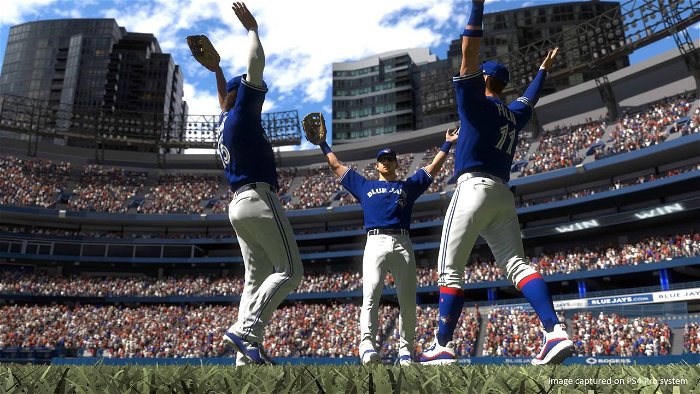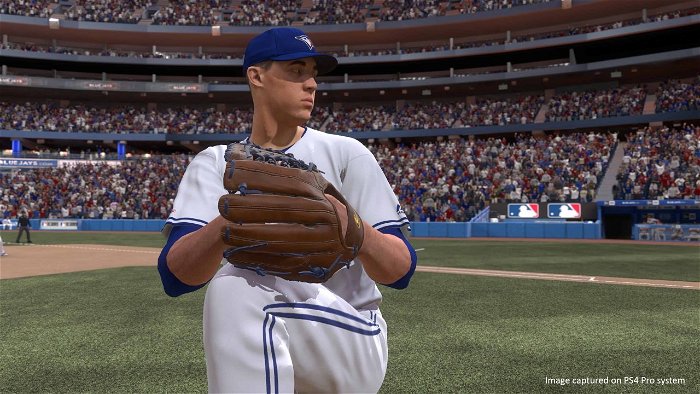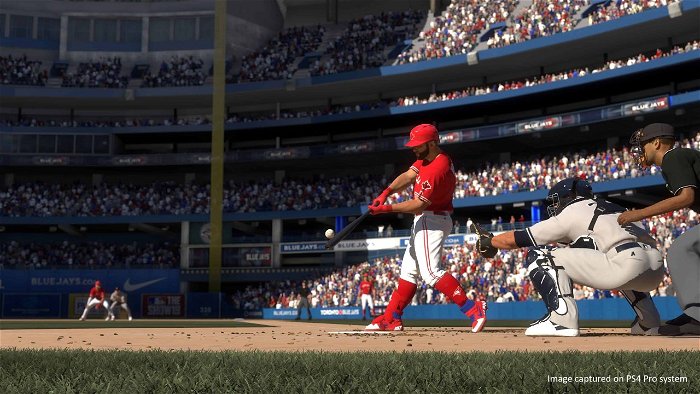It’s late March and that means that it’s time for the newest instalment of Sony’s long-running baseball simulator, MLB The Show.
For Game Designer Ramone Russell, MLB The Show 19 marks more than a decade since he started working on the series, yet he still finds ways to improve and innovate on a yearly basis.
CGMagazine’s Alex Handziuk got the chance to talk with Ramone about the new features and improvements in MLB The Show 19, how he tackles the yearly release schedule and what players you should target for your Diamond Dynasty team.
CGMagazine: How is working on an annual title, where the core stays largely the same but you need to find reasons for people to buy it every year?
Ramone Russell: The things in the core that work really well, those will stay the same. But the things that aren’t working really well, or the missing pieces, that’s what we try to add every year. At the beginning of every
MLB The Show 19 ships on All-Star difficulty and the game is a little easier on the introductory levels. We made pitch speeds a bit lower and windows a bit wider. On the flip side, we also learned that for the people that are really really good at the game, the game’s not hard enough. So there are these two completely different narratives. Ninety-eight per cent of the people

CGMagazine: You replaced Immortals with Signature Series this year and these players have a set floor but also room for progression. How did you calculate the floor rating?
Ramone Russell: With Immortals there were two main reasons why fans didn’t like them. The main reason was that we were cherry picking attributes so everybody was god tier level. With Chipper Jones, for example, we found one year where he was really good against lefties and we used that as his hitting stat for the card. Secondly, there weren’t enough Immortals to choose from. The Immortals ended up being the end game card at every major position. The Ken Griffey Jr. Immortal was the best centre fielder, Babe Ruth was the best hitter, Albert Pujols was the best first basemen. With the Signature Series, there are going to be multiple picks at every position and they all have a weakness. You’re going to be sitting there judging, whether you want the Willy Mays card or the Tony Gwynn Signature Series because all of the signature series have pluses and minus. Again, every 100 levels of XP you’re gonna get one of these high profile guys.
CGMagazine: Fielding is something that your team has stressed as being improved in MLB The Show 19. What specifically has been changed from last year?
Ramone Russell: A big change this year is that our game is thinking all the time. If there’s a really fast guy in the batter’s box like Billy Hamilton or Dee Gordon, then the infielders will recognize the speed and get the throw off as quick as they can. Depending on who’s in the batter’s box, we will play different animations that match up accordingly. It’s very very important because if the game didn’t do that you’d notice and you’d question why the fielder is rushing that throw when the batter is slow. On the inverse, you’d also get mad if the batter is fast and the fielder didn’t rush the throw. We’ve added hundreds of new catch animations, hundreds of new throw animations and you can transition out of throws quicker and now you can transition out of tags as well. The entire fielding experience is more intuitive than ever before.

CGMagazine: XP Reward Path is a new progression system that you are bringing to MLB The Show 19. How does it work?
Ramone Russell: The way it works is that you play the game, gain XP and unlock stuff. It’s that simple. Whether you’re playing multiplayer or single player you’re constantly gaining XP, and the more XP you get the more you unlock. The first thing you unlock with XP Reward Path is a choice pack, which is also brand new to MLB the Show 19. A choice pack, as the name suggests, is a card pack with a few different items in it, and you get to choose one item every time you open a pack. As you level up you get different rewards and different packs to open. At level 10 you get a card pack, at level 15 you get a choice pack, at level 20 you get a gold player, at level 50 and 75 you get the choice of one of 30 different diamond players, and when you finally hit level 100 you get to choose a 99 rated player in the game. Of course, you get to use that 99 rated player on your Diamond Dynasty team, and all you have to do to unlock all these rewards is play the game, however you want to.
Moments is one of the new game modes that you are bringing to the Show this year. What is it all about?
Ramone Russell: With Moments you’re able to relive, rewrite or have a fantasy moment that takes place somewhere in baseball’s history. These are very much storyline moments. The Chicago Cubs won the 2016 World Series and so we looked back on the season and created these bite-sized pieces of gameplay for you to try to relive from that season. What’s really fantastic about Moments is it could be anything from one at-bat to eleven games, and you get different XP and rewards based on the difficulty and length of the moment. For example, we have a Rookie Bryce Harper storyline and by finishing it you unlock a 2012 Bryce Harper card, as well as XP. What’s really dynamic about Moments is that we can create them in around an hour. So as soon as Bryce Harper signed with the Phillies, we were able to get started on a moment and had it done in 30 minutes. That m
Going forward, we can create new Moments and we can throw it in the game via updates. And then going back to storyline moments we have classic ones like Babe Ruths’ and Willy Mays’ careers. Eventually, we’re going to release the Ken Griffey Jr. career storyline moment and there will be a moment in there where you’re trying to recreate that father and son back-to-back home run. Some of the Moments can be hard. Some of them are not as hard and there’s really something for everyone.

CGMagazine: What went into the creation of March to October?
Ramone Russell: March to October was born out of the curation and thinking about, what do fans want from a season based mode? We did a lot of research, talked to a lot of fans and we found out that most people never finish a full season mode. They’ll stop or they’ll get discouraged and they just won’t finish. So as we started to talk to more and more people, we learned that baseball is very regional, that you care about your team. People want a curated narrative experience that’s dynamic but also very, very focused on their team. So all 30 teams are broken down into four categories: favourites, contenders, underdogs and long-shots. The Toronto Blue Jays, for example, are long shots. On the other side, the Cubs and the Washington Nationals are favourites. So all of these teams have expectations going into the season. The fun part is that you’re able to change the narrative with the Toronto Blue Jays. We want you to shock the world. Their projected wins are 68 but throughout your play, you can change their trajectory, and you can get them into the playoffs and into the World Series. March to October is literally a play on words. It’s a march to get to October. So we had to ask ourselves how to do this without having to play 162 games. So what we do is we throw you into key moments of the season in the later innings. And if you win or lose those games, it will affect your momentum factor. That momentum factor will govern what happens between the simulated games that you are playing. So if you get a lot of momentum during the simulated games, you might tend to win more.
CGMagazine: How does the momentum play into the way the mode is presented?
Ramone Russell: All 30 teams have this narrative video which basically kicks off where the team ended last year, what the expectations are going forward, and that’s how we kick off-March to October. It’s about these curated experiences that are very team specific but also dynamic. The fact is that as you’re playing, as you’re winning and losing, the storyline will start to change accordingly. In the videos, we have Heidi White, who is the first on-field reporter we’ve had. She’s captured completely through motion capture as well. Heidi and the commentators will be talking about your team based on the momentum that you have. So if you hit a walk-off last game then they’ll be talking about the walk-off during the start of the next game and how it’s changed your team’s momentum. The other thing is that the season changes depending on how well you do. You’re going to see at least 20 episodes so you can start March to October and potentially get to the playoffs in around 12 to 18 hours, as opposed to having to play 162 games or having to sim.
You also get different rewards depending on what difficulty you play on and how well you do in the season. If you beat March to October on any difficulty level as the Toronto Blue Jays, you’ll get a universal profile icon which is Toronto Blue Jays specific. You’ll get a Shawn Green rookie card, a Blue Jays nameplate, 500 stubs and a 2016 breakout Aaron Sanchez card. If you can beat it on Legend, you get a card pack, an exclusive foghorn stadium sound, and you also get a breakout Edwin Encarnacion card. These change per team so there’s really going to be a reason to play March to October with all the teams because these rewards are really cool.
Stay tuned for CGMagazine’s review of MLB The Show 19!




